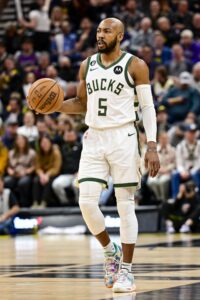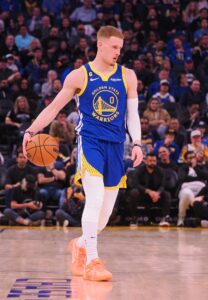In addition to receiving approximately $136MM in cap room and being allowed to surpass that threshold in order to sign players using Bird Rights or the minimum salary exception, each NBA team also receives a mid-level exception. The value of this exception varies depending on a club’s total team salary.
A team that goes under the cap to use its available cap room, for instance, receives a form of the MLE known as the room exception. An over-the-cap team receives the full mid-level exception, unless that team is also over the first tax apron, in which case it gets a modest taxpayer version of the MLE. A team whose salary is over the second tax apron isn’t permitted to use its mid-level at all.
We detailed the exact values of each form of mid-level exception earlier this offseason, but here’s a quick breakdown:
- Room exception: Can be used for contracts up to three years, with a starting salary worth up to $7,723,000.
- Taxpayer mid-level exception: Can be used for contracts up to two years, with a starting salary worth up to $5,000,000.
- Full/non-taxpayer mid-level exception: Can be used for contracts up to four years, with a starting salary worth up to $12,405,000.
- Note: Though its name suggests otherwise, using the non-taxpayer mid-level exception doesn’t mean a team can’t or won’t be above the tax line ($165,294,000) at season’s end; it simply means the team’s total salary can’t surpass the first tax “apron” ($172,346,000).
Now that most of the NBA’s teams have used up their cap space, it’s worth keeping an eye on which teams still have part or all of their mid-level exceptions available, which we’ll do in the space below.
This list will be kept up to date throughout the 2023/24 league year, with new MLE deals added once those signings are officially completed and we confirm the contract details.
Note: After the 2024 trade deadline, the value of the exceptions below will begin to prorate downward.
Here’s where things currently stand:
Mid-Level Exception:
Non-taxpayer: $12,405,000
Taxpayer: $5,000,000
Atlanta Hawks
- Used: $0
Boston Celtics
- Used: $0
- Note: The Celtics are limited to the taxpayer mid-level exception, at best.
Brooklyn Nets
- Used: $850,000 (Jalen Wilson)
Charlotte Hornets
- Used: $0
 Chicago Bulls
Chicago Bulls
- Used: $6,190,476 (Jevon Carter); $500,000 (Onuralp Bitim)
Cleveland Cavaliers
- Used: $8,800,000 (Georges Niang); $1,500,000 (Craig Porter Jr.)
Dallas Mavericks
- Used: $3,000,000 (Dante Exum); $4,000,000 (Seth Curry); $1,000,000 (A.J. Lawson)
- Note: The Mavericks used $10.5MM of their mid-level exception to sign Matisse Thybulle to an offer sheet, but it was matched by the Trail Blazers, freeing up Dallas’ MLE.
Denver Nuggets
- Used: $5,000,000 (Reggie Jackson)
- Note: The Nuggets are limited to the taxpayer mid-level exception.
Golden State Warriors
- Used: $0
- Note: The Warriors are over the second tax apron and don’t have the mid-level exception available.
Los Angeles Clippers
- Used: $0
- Note: The Clippers are over the second tax apron and don’t have the mid-level exception available.
Los Angeles Lakers
- Used: $10,500,000 (Gabe Vincent); $1,554,655 (Spencer Dinwiddie)
Memphis Grizzlies
- Used: $5,000,000 (Bismack Biyombo); $2,232,308 (Vince Williams); $1,991,428 (GG Jackson)
Miami Heat
- Used: $0
- Note: The Heat aren’t expected to have the mid-level exception available due to their proximity to the second tax apron.
Milwaukee Bucks
- Used: $0
- Note: The Bucks are over the second tax apron and don’t have the mid-level exception available.
Minnesota Timberwolves
- Used: $5,000,000 (Shake Milton); $4,000,000 (Troy Brown)
New Orleans Pelicans
- Used: $1,801,769 (E.J. Liddell); $1,500,000 (Matt Ryan)
 New York Knicks
New York Knicks
- Used: $11,650,000 (Donte DiVincenzo)
Philadelphia 76ers
- Used: $2,795,839 (Kyle Lowry); $864,353 (Ricky Council)
- Note: Limited to taxpayer mid-level exception.
Phoenix Suns
- Used: $0
- Note: The Suns are over the second tax apron and don’t have the mid-level exception available.
Portland Trail Blazers
- Used: $1,951,220 (Duop Reath)
Toronto Raptors
- Used: $12,405,000 (Dennis Schröder)
Washington Wizards
- Used: $900,000 (Eugene Omoruyi); $2,424,892 (Tristan Vukcevic); $1,250,000 (Jared Butler)
Room Exception:
Available: $7,723,000
Detroit Pistons
- Used: $0
Houston Rockets
- Used: $0
Indiana Pacers
- Used: $1,100,000 (Kendall Brown)
Oklahoma City Thunder
- Used: $7,723,000 (Vasilije Micic)
Orlando Magic
- Used: $0
Sacramento Kings
- Used: $6,341,464 (Sasha Vezenkov); $683,430 (Keon Ellis)
San Antonio Spurs
- Used: $0
Utah Jazz
- Used: $500,000 (Kenneth Lofton Jr.); $500,000 (Darius Bazley)
- Note: The Jazz used their room exception to sign Paul Reed to an offer sheet, but it was matched by the Sixers, freeing up Utah’s exception.
So let me see…………
Bird Rights
Minimum Salary Exemption
Mid Level Exemption
Tax Payer Line
First Tax Apron
Trade Deadline
Salary Cap
BUT
teams ARE allowed to surpass that threshold in order to sign players using Bird Rights.
teams ARE allowed to surpass that threshold in order to sign players using the minimum salary exception.
AND
each NBA team also receives a mid-level exception.
EXCEPT THAT
The value of this exception varies depending on a club’s total team salary.
AND THEN
A team that goes under the cap to use its available cap room, receives a form of the MLE known as the room exception.
HOWEVER
An over-the-cap team receives the full mid-level exception, unless that team is also over the first tax apron, in which case it gets a modest taxpayer version of the MLE.
BUT THEN
A team whose salary is over the second tax apron isn’t permitted to use its mid-level at all.
IN SUMMARY
Room exception: Can be used for contracts up to three years, with a starting salary worth up to $7,723,000.
Taxpayer mid-level exception: Can be used for contracts up to two years, with a starting salary worth up to $5,000,000.
Full/non-taxpayer mid-level exception: Can be used for contracts up to four years, with a starting salary worth up to $12,405,000.
Note: Though its name suggests otherwise, using the non-taxpayer mid-level exception doesn’t mean a team can’t or won’t be above the tax line ($165,294,000) at season’s end; it simply means the team’s total salary can’t surpass the first tax “apron” ($172,346,000).
ALSO TAKE INTO ACCOUNT
After the 2024 trade deadline, the value of the exceptions will begin to prorate downward.
JUST WHO IS DREAMING UP ALL OF THESE “BS” RULES??
Here’s an idea.
$150 MM TEAM HARD SALARY CAP.
NO EXCEPTIONS, NO EXEMPTIONS, NO EXCLUSIONS
UNDER ANY CIRCUMSTANCES
How about no?